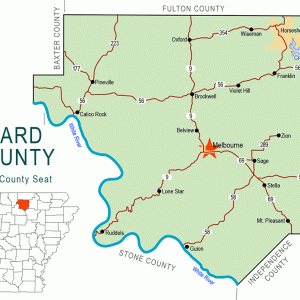calsfoundation@cals.org
Oxford (Izard County)
| Latitude and Longitude: | 36º13’16″N 091º55’46″W |
| Elevation: | 784 feet |
| Area: | 6.54 square miles (2020 Census) |
| Population: | 573 (2020 Census) |
| Incorporation Date: | November 16, 1945 |
Historical Population as per the U.S. Census:
|
1810 |
1820 |
1830 |
1840 |
1850 |
1860 |
1870 |
1880 |
1890 |
1900 |
|
– |
– |
– |
– |
– |
– |
– |
– |
– |
– |
|
1910 |
1920 |
1930 |
1940 |
1950 |
1960 |
1970 |
1980 |
1990 |
2000 |
|
– |
– |
– |
– |
79 |
191 |
271 |
520 |
562 |
642 |
|
2010 |
2020 |
|
|
|
|
|
|
|
|
|
670 |
573 |
|
|
|
|
|
|
|
|
The city of Oxford was not incorporated until 1945, although it has been an active settlement since the middle of the nineteenth century. Located on Highway 9 in Izard County, Oxford is about halfway between Melbourne (Izard County) and Salem (Fulton County).
One of the first settlers to arrive in what would become Oxford was Wiley Croom. He joined William McCollough and James McCuistion, both of whom were evidently already living in the area, although they did not register their land grants at the federal land office until the 1850s. Croom built and operated the first cotton mill and the first grist mill in the region. He later added the first cotton gin, which was also the last cotton gin operating in Izard County until it closed around 1963. Croom and his wife, Jane, raised six sons and four daughters. Croom served in the Confederate army during the Civil War and was held as a prisoner of war for two years. A minor skirmish was fought near the Croom farm in December 1863. Following the war, other families arrived in Izard County and settled near the mills. When a post office was established in the settlement in 1878, the name Crooms Mill was selected. Four years later, postmaster Emory Pearson renamed the post office Oxford after his hometown of Oxford, Mississippi.
A Cumberland Presbyterian church was established in Crooms Mill in 1870. Around the same time, a schoolhouse was built northeast of Crooms Mill. It was named Richardson School for a local farm family. A few years later, a one-room schoolhouse was built in town. Additional rooms were added to the building as the settlement grew. Early residents included William Davis, a blacksmith who also made caskets; brothers William and Arch Garner, who ran a sawmill; and their brother Joseph, who opened the first store in Oxford and also ran stores in Hardy (Sharp County) and Calico Rock (Izard County). A newspaper started by K. W. C. Haun and G. W. Seay in Newburg (Izard County) in 1883 was moved to Oxford after a few months; the name was changed from the Newburg Magnet to the New Magnet, but it was published for only two years.
Around 1900, John Rowden opened the Rowden Hotel in Oxford. The Bank of Oxford opened in 1919; it closed in 1931 during the Depression. A Methodist church was organized in Oxford and, for a time, shared the Presbyterian church building. In 1937, a Baptist church was also established. In 1945, residents voted to incorporate Oxford as a second-class city. Long-distance telephone service began in 1947. In 1948, the schoolhouse was razed and replaced with a stone structure.
Oxford’s school system was consolidated with the Violet Hill (Izard County) school district in 1985, which was then made part of the Izard County Consolidated District. Schoolchildren are bused to schools in Violet Hill and Brockwell (Izard County). Oxford’s older businesses, including the mills and cotton gin, the Garner store, and the Rowden hotel, have closed. A spice store called Townsend Supplies ran a business in Oxford for several years but then moved to Melbourne. Still, the city survives in the twenty-first century with a convenience store, a small grocery store, and a café. The community’s three churches (Baptist, Methodist, and Cumberland Presbyterian) continue to meet. The Methodists and Presbyterians again share a building, as they had done during the Depression. A Church of Christ congregation met for a time in a downtown building. A Missionary Baptist congregation, affiliated with the American Baptist Association, meets on the southern outskirts of Oxford.
The most famous person to come from Oxford is Adlai Stevenson Croom. Son of original settler Wiley Croom, the younger Croom was a preacher who helped to organize Arkansas Christian College in Morrilton (Conway County) in 1922. He served as the college’s president until 1924, when it merged with Harper College of Kansas, creating Harding College—now Harding University in Searcy (White County). Croom was the first vice president of Harding College, before working with other Christian colleges in Kansas and Oklahoma.
For additional information:
Stowers, Juanita. The History and Families of Izard County, Arkansas. Paducah, KY: Turner Publishing Company, 2001.
Thompson, Frankie. “Oxford and its Pioneers.” Izard County Historian 4 (October 1973): 2–17.
Steven Teske
Butler Center for Arkansas Studies
 Izard County Map
Izard County Map 



Comments
No comments on this entry yet.